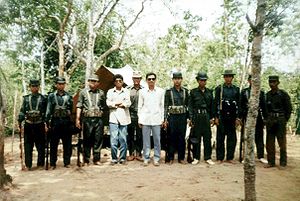User:Sailingsmooth5/Insurgency in the chittagong hill tracts
| Chittagong Hill Tracts conflict | |||||||
|---|---|---|---|---|---|---|---|
 Shanti Bahini insurgents, photographed on 5 May 1994. | |||||||
| |||||||
| Belligerents | |||||||
| Supported by: | |||||||
| Commanders and leaders | |||||||
|
| |||||||
| Units involved | |||||||
|
Paramilitary Forces:Law Enforcement: | |||||||
| Strength | |||||||
| |||||||
| Casualties and losses | |||||||
| 6,000+ combatants killed (partial list)[5] | |||||||
|
3,500–25,000 civilians | |||||||
setup:
| Insurgency in the Chittagong Hill Tracts | ||||||||
|---|---|---|---|---|---|---|---|---|
| ||||||||
| Belligerents | ||||||||
|
Somo Adhikar Andolon Mog Party |
|
Supported by: | ||||||
| Commanders and leaders | ||||||||
|
|
|
| ||||||
| Units involved | ||||||||
|
Government Forces: Paramilitaries: Armed Bengali Settlers
|
|
| ||||||
| Strength | ||||||||
|
|
| |||||||
| Casualties and losses | ||||||||
|
Bangladesh: 16+ killed[7]Bengali Settler Groups: 190 Bengali settlers killed (mostly civilian)[7]
10 killed |
|
200+ civilians displaced | ||||||
| 2,199 killed overall (1997-2017)[8] | ||||||||
- ^ a b Cite error: The named reference
nyt11Jun1989was invoked but never defined (see the help page). - ^ a b Dowlah, Caf (2013). "Jumma insurgency in Chittagong Hills Tracts: how serious is the threat to Bangladesh's national integration and what can be done?". Small Wars & Insurgencies. 24 (5): 775, 788–789. doi:10.1080/09592318.2013.866419. S2CID 144593890.
- ^ a b c d Fortna, Virginia Page (2008). Does Peacekeeping Work?: Shaping Belligerents' Choices after Civil War. Princeton University Press. pp. 53–. ISBN 978-1-4008-3773-1.
- ^ a b c d Talukdar, S. P. (1988). The Chakmas, life and struggle. Delhi: Gian Pub. House. p. 52. ISBN 81-212-0212-4.
- ^ Bangladesh/Chakmas (1972-present)
- ^ "3 ALP and MOG Party terrorists killed in opponents shots in Bandarban". Hill Voice. March 22, 2022.
- ^ a b "Bangladesh: CHT and Violent Factionalism – Analysis". Eurasia Review. August 31, 2022.
- ^ "CTG Hill tracts: The contested relationships and resources". Bangla Tribune. June 04, 2018.
{{cite web}}: Check date values in:|date=(help)
